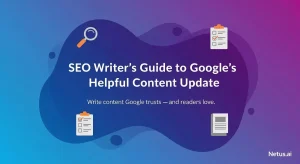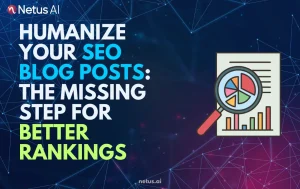
Why Google’s ‘Who, How, Why’ Framework Matters for EEAT | NetusAI
Why Google’s ‘Who, How, Why’ Framework Matters for EEAT AI can create articles in seconds. But here’s the truth: speed is not enough. Google wants

Content writer and editor for Netus.AI
Research Paper Citation. In the realm of academia, plagiarism has become a growing concern for educational institutions. Plagiarism cases continue to rise, posing a threat to the reputation of schools and other establishments. Strict policies are implemented to address students involved in committing plagiarism, as these allegations can have a lasting impact on their careers.
To avoid plagiarism and its consequences, students must ensure they properly credit their sources when writing papers. Proper research paper citations play a crucial role in upholding academic honesty. Failure to cite articles correctly can lead to instances of plagiarism, and research papers should be thoroughly checked for any such issues.
Citation is a crucial aspect of academic writing, as it allows the acknowledgment of other people’s work when incorporated into one’s own research or argument. By adhering to citation guidelines, authors can maintain a consistent and structured referencing approach.
The fundamental purpose of a citation is to provide a clear trail back to the original source while avoiding plagiarism. Citation styles, such as APA, MLA, and Chicago, offer guidelines to ensure proper credit is given to the source. During the writing process, both direct quotations and paraphrases must be cited, with relevant details like the author’s name, page number, publisher, and the date of publication.
The Purdue OWL is a reliable resource for understanding various citation styles and adhering to academic writing standards. By following the rules set forth by the citation style and incorporating the necessary information in their work, researchers and students can respect copyright and avoid any legal consequences while producing valuable contributions to their field of study.
Citing sources, such as books, journals, newspapers, and websites, plays a crucial role in academic and professional communication. To avoid plagiarism – taking someone else’s work and presenting it as your own – students and researchers should always give credit to the original source. This helps maintain ethical standards and demonstrates credibility in their writings.
Moreover, crediting sources showcases the writer’s extensive research on various source types, such as journal articles, lectures, and meta-analysis. It reflects a thorough understanding of the topic and contributes to a higher grade. Citing relevant sources also allows the reader to easily access and expand their knowledge of the subject matter.
Failing to cite sources can lead to serious consequences, such as legal actions, as countries have strict copyright laws. Violations may result in monetary compensation or other penalties. To ensure a responsible and trustworthy academic environment, always acknowledge the original authors and sources, thereby promoting proper knowledge-sharing.
When writing a research paper, citations play a crucial role in maintaining accuracy and avoiding plagiarism. However, several common mistakes tend to occur:
By being aware of these common citation mistakes and taking measures to prevent them, students can maintain an informative, accurate, and plagiarism-free research paper.
When citing sources in a research paper, it is essential to provide accurate and complete information for each work used. Here are some guidelines for proper citation:
Following these guidelines ensures that the paper’s citations are accurate, consistent, and provide the necessary information for readers to locate the original sources.
Citation styles are essential tools in academic writing, with various formats to choose from depending on the field of study. Notable styles include:
Other citation styles, such as Harvard referencing, Chicago style, and Vancouver style, cater to specific fields or preferences in format. Researchers may choose between numerical citation styles and note citation styles, as well as using footnotes or endnotes. Standard information includes the author’s name, publication, page number, and other relevant details for full citations. While each style may have unique variations, the main objective is to provide proper attribution and maintain consistency throughout the paper.
Plagiarism checkers play a vital role in helping students and researchers prevent accidental plagiarism in their academic work you just need to find the best paraphrasing tool for academic writing. By using such a tool, individuals can efficiently scan their content and identify any instances of plagiarism before submission.
Upon uploading a document, the tool conducts a thorough analysis, providing an informative report that points out any plagiarised sections and their respective sources. This enables users to properly cite these sources using various citation formats, such as APA citation generator. Additionally, tools like paraphrasing tool and academic proofreading tool can further enhance the quality and originality of their work.
To format citations in APA style, you need to include the author’s last name, the publication year, and sometimes page numbers for direct quotes. In-text citations follow the author-date system. For more details, refer to the Purdue OWL® APA guide.
MLA format citations typically consist of the author’s name, the title of the work, the publisher, and the publication date. In-text citations include the author’s name and the page number where the information was found. For more information, refer to the Purdue OWL® MLA guide.
Yes, there are differences in citation requirements for different research paper styles. Some common ones include APA, MLA, and Chicago. Each style has specific rules and formatting guidelines to follow. Refer to the respective style guidelines to ensure proper citation.
For proper in-text citation, follow the specific guidelines of the citation style you are using. In APA style, include the author’s last name and publication year, while in MLA style, use the author’s name and page number.
To reference multiple authors in a research paper citation, follow the rules of the specific citation style. In most styles, such as APA and MLA, you would list up to three authors in the in-text citation, using an ampersand (&) or “and” between the last two authors, and use “et al.” for four or more authors.
To create a reference list in Microsoft Word:
Make sure to format the list according to the specific citation style you are using.

Why Google’s ‘Who, How, Why’ Framework Matters for EEAT AI can create articles in seconds. But here’s the truth: speed is not enough. Google wants

SEO Writer’s Guide to Google’s Helpful Content Update Keeping up with Google’s algorithm changes can feel like a relentless game of whack-a-mole. Just when you

Can AI Content Be Safe for SEO in 2025? Let’s start with the question of keeping every content strategist, SEO pro and blogger awake at

Humanize Your SEO Blog Posts: The Missing Step for Better Rankings You’ve done everything by the book. Your keyword research is impeccable. Your meta descriptions

How to Pass AI Detection Tests as an SEO Writer Let’s paint a familiar picture. You’ve just finished a blog post. The headline is sharp,

Why Your AI SEO Blog Isn’t Ranking (And How to Fix It) You embraced AI for your blog. The promise was intoxicating: high-quality content, published
@ 2024 Netus AI.